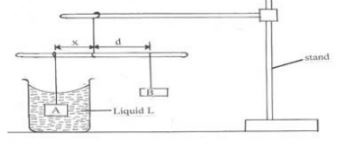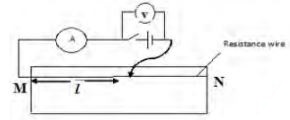PHYSICS
Paper 3
Instructions to candidates:
- You are supposed to spend the first 15 minutes of 2½ hours allowed for this paper reading the whole paper carefully before commencing the work.
- Marks are given for clear record of the observations actually made, their suitability, accuracy and the use made of them.
- Candidates are advised to record their observations as soon as they are made.
- Non-programmable silent electronic calculators and KNEC Mathematical table may be used.
- All questions must be answered in English

Questions
QUESTION 1
- You are provided by the following:-
- One concave mirror
- One mirror holder
- White screen
- Metre rule
- Some plasticine
- One candle
- Procedure:-
- find the focal length of the mirror provided ………………. Cm ( 1mark)
- Set the apparatus as shown in the diagram below
- Place the mirror from one end of the metre rule as shown on the diagram
- Place the lit candle in front of the mirror at a distance u = 22.0cm ( Note: The cross wire becomes the object)
- Place the screen from the other end as shown then vary the screen to and fro until a sharp inverted image of the candle flame is obtained on it.(Note: you can displace the screen alittle so that reflected rays from the mirror are not blocked by the object)
- Now measure distance V, between the mirror and the screen
- Repeat the procedure in (v) above with distance u equal to 26cm, 30cm, 34cm, 38cm and 42cm; each time recording the corresponding distance V in the table below:
Ucm 22 26 39 34 38 42 Vcm M - Calculate the value of magnification M and compete the table above (8marks)
- Plot a graph of M on vertical axis against V (5marks)
- From your graph, determine the value of M when V = 40cm
M = ........................................... (1mark) - Determine the slope of your graph (3marks)
- Given that the equation of the above graph is: M = V/F – 1
Determine the value of F (2marks)
QUESTION 2
This question has two parts A and B. Answer all the parts
PART A
You are provided with the following:
- A metre rule
- Two identical 100g masses (labelled A and B)
- Liquid L in 250ml beaker,???? full.
- Three pieces of thread, each 30cm long.
- Stand with clamps
- Tissue paper.
- Vernier calipers
Proceed as follows:
- Take one 100g mass and measure the diameter d and height h using the Vernier calipers d=………………………………..m
h=………………………………..m (1mark) - Determine the volume V given that ??=??(??2)2h
V…………………………………………m3 (1mark) - Using a stand and one piece of thread, suspend the metre rule in air such that it balances horizontally. Record the position of the centre of gravity. G.
G = ____________________________ cm (1mark)
NOTE: The metre rule should remain suspended at this point throughout the experiment. - Set up the apparatus as shown in the figure below;
- Suspend the mass A at a distance x = 30cm and completely immerse it in liquid L without touching the sides of the beaker.
- Hang mass B and adjust its position such that the rule is balanced and measure the distance d cm. Tabulate your results in table 1 below
x(cm) 30 35 40 d(cm) d/x
- Determine the weight F of one of the masses A or B in air. Given that
g=10N/Kg and A =B
Weight F in air =…………………………………… (1mark) - Using the principle of moments, determine the apparent weight P of A when completely immersed in liquid L.
Apparent weight P = …………… (2marks) - Find the upthrust U on A when completely immersed. (1marks)
Upthrust; U =……………………………………………. - Determine the density of liquid L, given that; (1mark)
ρ=Un/V where n = 0.1Kg/N
PART B
You are provided with the following apparatus:
- Resistance wire fitted on a millimeter scale labeled MN
- Switch
- Voltmeter
- Ammeter
- One dry cells in a cell holder
- Six connecting wires
- Micrometer screw gauge
- Set –up the apparatus as shown in the Figure 2 below;
- Remove the crocodile clip from the resistance wire MN and close the switch. Record the voltmeter reading V0.
V0 = …………………………………. (1mark) - Attach the Jockey to the resistance wire such that l = 50cm
- Record the voltmeter and ammeter readings as V1 and I1 respectively
V1 =…………………………………....... (1mark)
I1 =……………………………………… (1mark) - Determine the value of ∅ given that ∅= V1/l1 (1mark)
- Use the equation below to determine the value of k , where m = 2.549Ω (2marks)
V1/V0−V1 = m∅/5 + k - Measure the diameter d of the of the wire on the millimeter scale using the micrometer screw gauge
d = …………………………mm =……………………………….m (2marks) - Determine the resistivity ρ of the wire used in this experiment given that ∅=ρl/A(2marks)
- Set –up the apparatus as shown in the Figure 2 below;
Download Physics Paper 3 Questions - Maranda Mocks 2021/2022 Exams.
Tap Here to Download for 50/-
Get on WhatsApp for 50/-
Why download?
- ✔ To read offline at any time.
- ✔ To Print at your convenience
- ✔ Share Easily with Friends / Students




